Dear creative friends,
Welcome to Issue No. 67 of the StudioWorks Journal! As always, I’m super grateful you are here with me and I’m excited to share this with you. This month, we dive into the whimsical and enchanting world of Naïve art. Historically rich and profoundly expressive, Naïve art invites us to explore the essence of playfulness, simplicity, and joy.
As artists, there is so much we can learn from the untrained yet profoundly genuine expressions of Naïve artists. How can we bring more playfulness into our creations? How can we embrace simplicity in our work, allowing our true emotions to shine through? Naïve art teaches us that joy can be found in every brushstroke, in every color, and in every mark we make.
Join me in this issue as we celebrate the beautiful and unpretentious world of Naïve art. Together, let's explore how we can infuse our own art with the same spirit of wonder, authenticity, and delight that defines this remarkable genre.
xo,

So you may be wondering, where do I start? To that, I say, wherever feels right to you. Each month we will have a theme, a creative affirmation, a power word, a color palette, sketchbook exercises, art projects, articles, recommended reading, and access to wonderful inspiration and resources. I want you to think of this as a delicious new magazine, you know the ones you occasionally splurge on, with soft, velvety pages, beautiful images, and inspiring content!
Each issue will invite you to explore your creative practice in whichever way works for you. Experience each issue at your own pace. Take what resonates with you and put the rest aside for another time.
Grab a cup of something lovely and dive in.
People have been creating art for millennia, and for most of that time, there wasn’t a set of rules defining how to make it and what qualities were required for it to be considered good. Advancements in science and technology allowed us to understand things like forced perspective and vanishing point to add realism to our works. Still, these discoveries never supplanted the essential need to simply express ourselves and our unique way of viewing the world.
The Naïve Art movement is a testament to this need and to the power that can be captured by art that isn’t the result of training and expertise but rather something more spontaneous and raw. By celebrating artists who weren’t confined by formal rules, this movement included a broader array of work and infused the art world with freshness and accessibility. Join me in exploring the rich history of Naïve Art and its value for us as artists.
While the exact beginnings of Naïve Art are subject to debate, understanding its overlap with, and distinction from, related movements like Primitivism, Folk Art, Art Brut, and Outsider Art can provide clarity. Primitivism is often defined as formally trained artists imitating an unsophisticated style. Folk Art more often has utility and springs out of larger cultural phenomena and influence. Art Brut, a term coined by Jean Debuffet, translates to raw art. It is considered synonymous with Outsider Art, which also refers to artists who make art for its own sake and create outside the influence of artistic or social norms.
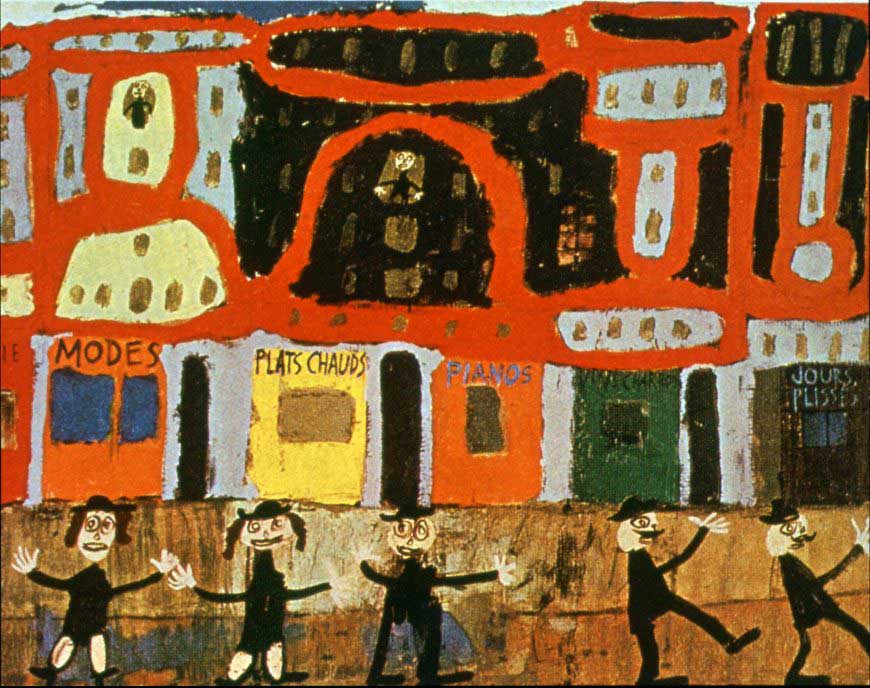
View of Paris, The Life of Pleasure
By Jean Dubuffet, 1944
For its part, Naïve Art is fine art made by unschooled artists (though, perhaps ironically, there are now academies of Naïve Art). A particular trademark of the style is the absence of the three rules of perspective honored by Renaissance Painters. Namely, objects are smaller the farther away they are, colors are more muted as they fade into the distance, and there is less detail the further away things are. By throwing out these rules, Naïve Art toys with our perception, making images appear to float and drawing our gaze across the piece as details abound and colors remain richly saturated no matter their location.
Fortunately, one thing about Naive Art is crystal clear. Almost everyone agrees that Henri Rousseau is the official godfather of the movement. Paintings such as The Dream epitomize the energy and essential qualities of the style. In addition, his lack of formal training, use of bright, saturated colors, disregard of traditional perspective, great attention to detail, intensely imaginative scenes, and emphasis on feeling over technique contain the hallmarks of Naive Art.
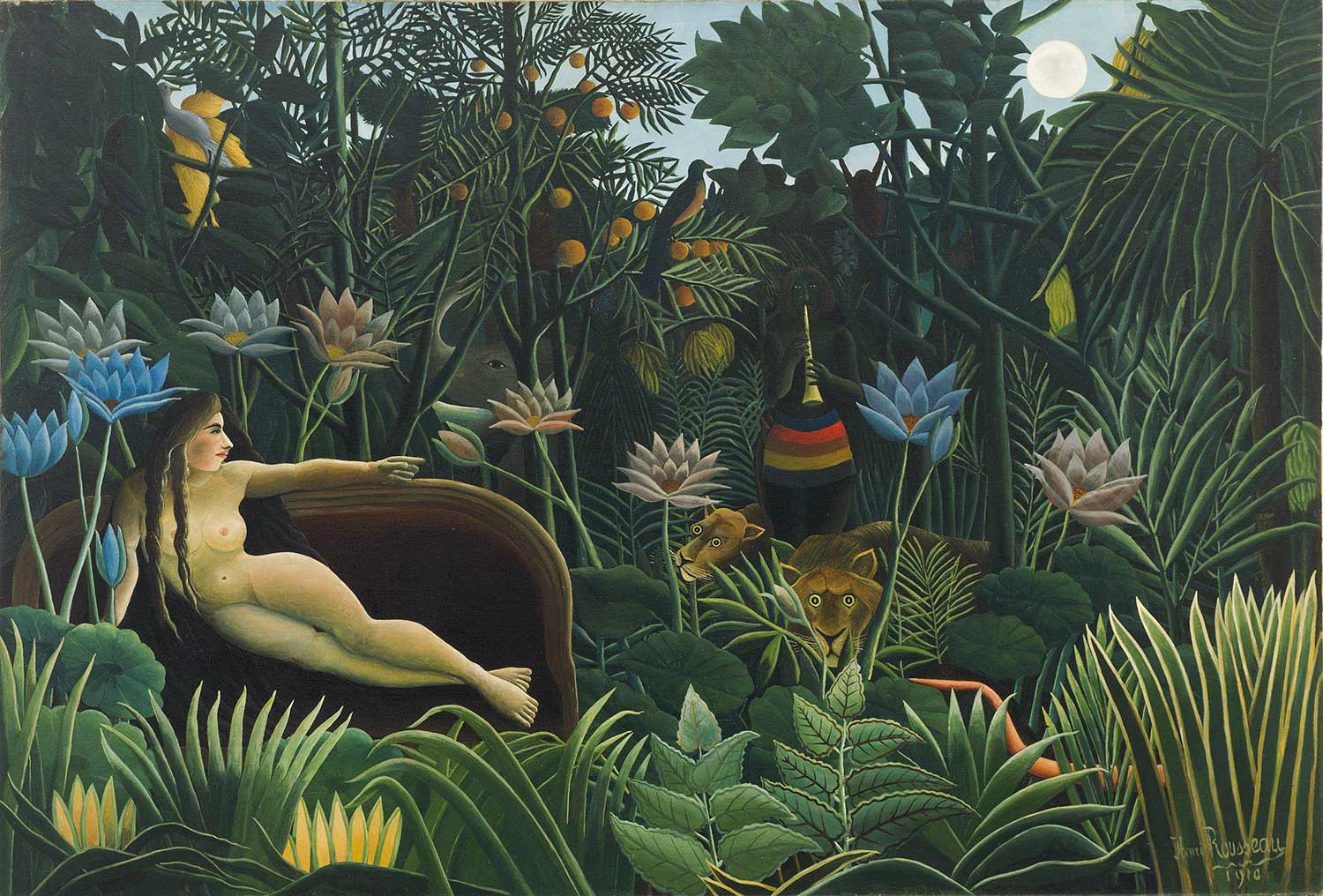
The Dream
By Henri Rosseau, 1910
In keeping with his honorary position, the official timeline of Naïve Art is thought to be when Rousseau’s work was “discovered” by the artist Paul Signac in 1885. He promptly worked to get Rousseau’s paintings into exhibits. By 1912, the Naïve Art movement was solidified in the annals of art history by a publication of six of Rousseau’s pieces in the almanac Der Blaue Reiter, a publication by an avante-garde collective of artists who helped shaped the trajectory of modern art as we know it.
The first show of Naïve Art occurred in Paris in 1928. It was organized by German art critic and collector Wilhelm Uhde and included pieces by Louis Vivin, Henri Rousseau, Séraphine Louis, Camille Bombois, and André Bauchant. This group became known as the Sacred Heart Painters. This title represented the soulfulness of this collective of autodidacts who evinced a connection to nature and an unpretentious and delightfully beguiling immediatism. Their work was particularly inspiring to other artists, and became the vanguard of many avant-garde movements.
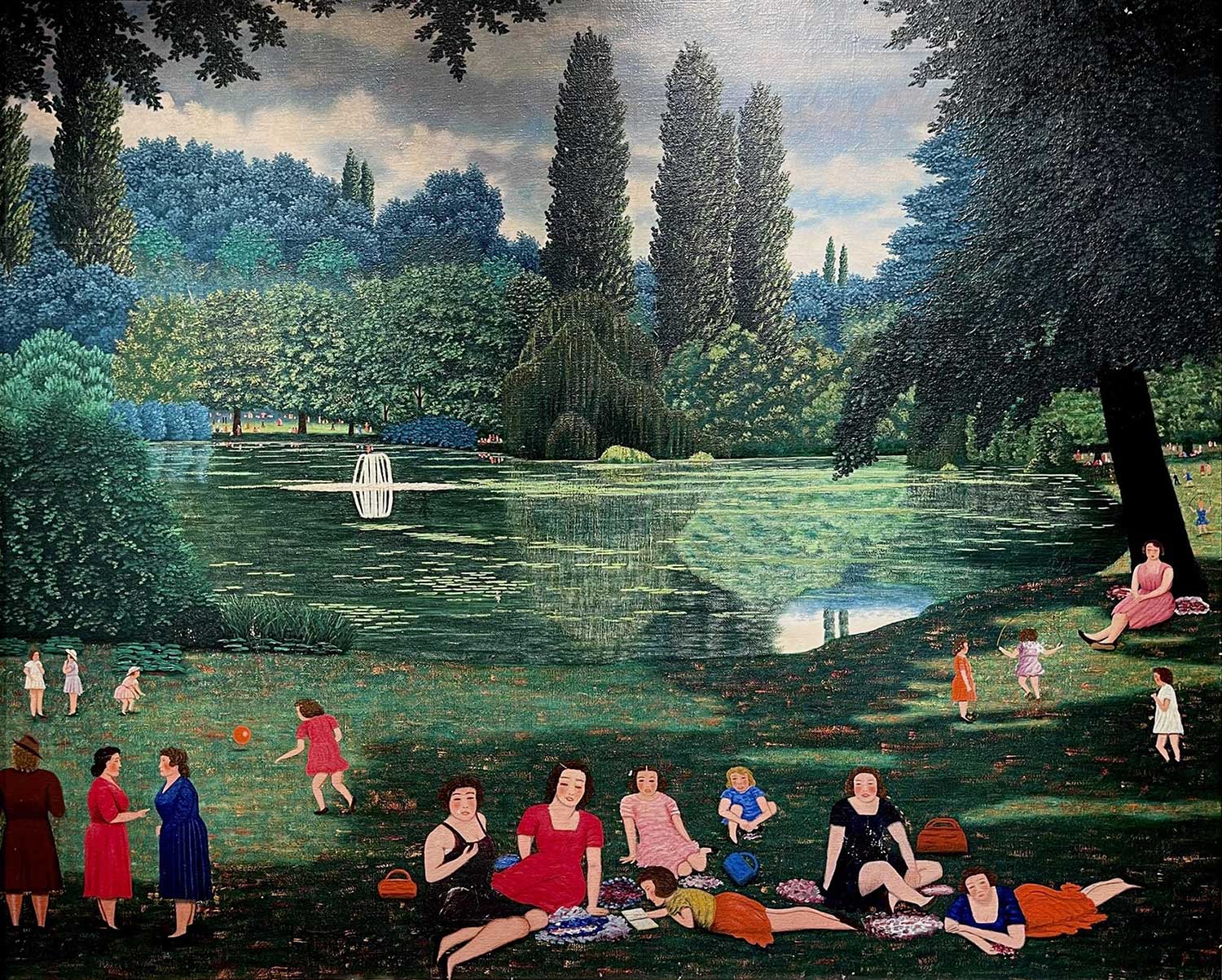
The Park of Baden
By Camille Bombois 1964
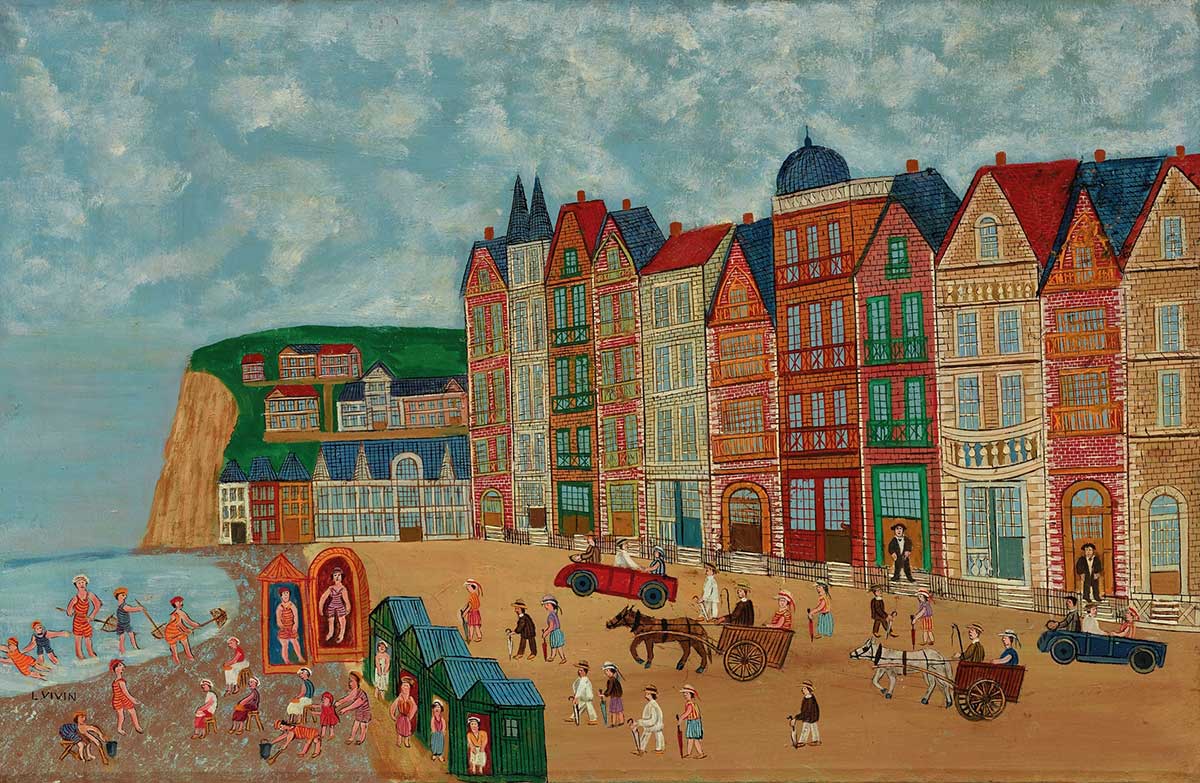
Bord de mer, baigneurs et plage
By Louis Vivin, 1936
Being a self-taught artist no longer bears the weight of societal disapproval. At this juncture, we can honor creative expression in myriad forms without being confined by rigid rules and the requirement of formal education. Much of this freedom stems from the efforts of those in the Naïve Art movement.
Even if it wasn’t their intention, by letting their creative spirit have its say, regardless of what the world was telling them, these artists lent credibility to personal expression that celebrates individuality, leaves room for the unexpected, elevates the value of beauty in the eye of the beholder, and honors the power of what comes from the heart. These qualities will always be essential, and their value continues to reverberate.
Do you remember the first time you picked up a crayon or slapped bright colors onto paper, fingerpainting your way to a beautiful, inspired work that you graciously gifted to someone special (Mom, perhaps)? When recalling those early moments exploring the act of creation, many artists feel a thrill at the memory of first experiencing their ideas taking tangible form. At that point, there wasn’t a sense of limits; it wasn’t about being good at what you were doing; it just felt amazing to bring something to life and share it with others.
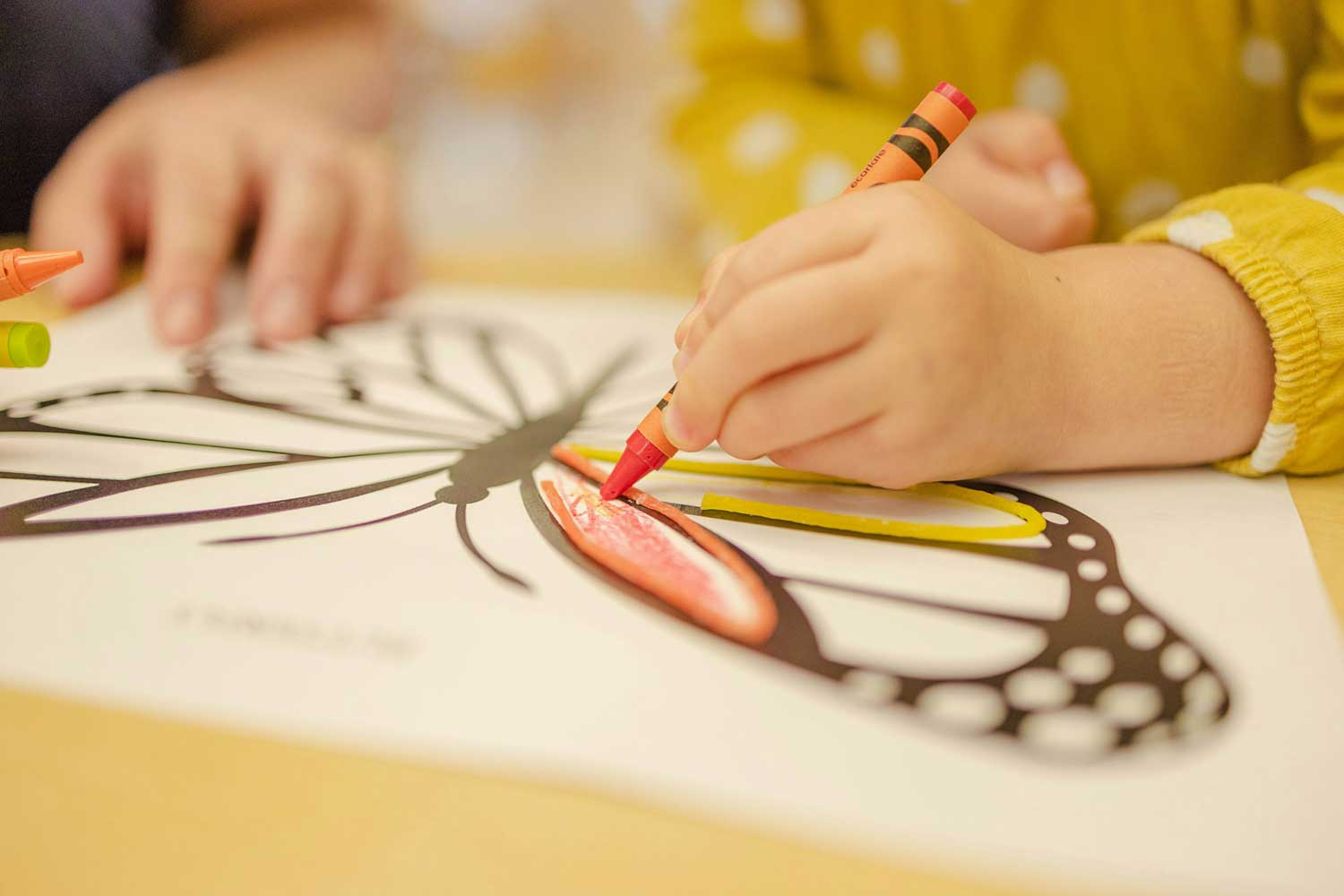
The power of Naïve Art is that it takes those unselfconscious attributes of the child artist and combines them with an adult's expanded understanding, vision, and physical ability. By making art that unabashedly rejects the rules or simply fails to consider them, something unique and imaginative is free to emerge. Great examples of this style are the works of Henri Rousseau and Grandma Moses, who are renowned for their Naïve Art. Join me in exploring the methods of artists such as these and discover how readily joy can be found by embracing simplicity.
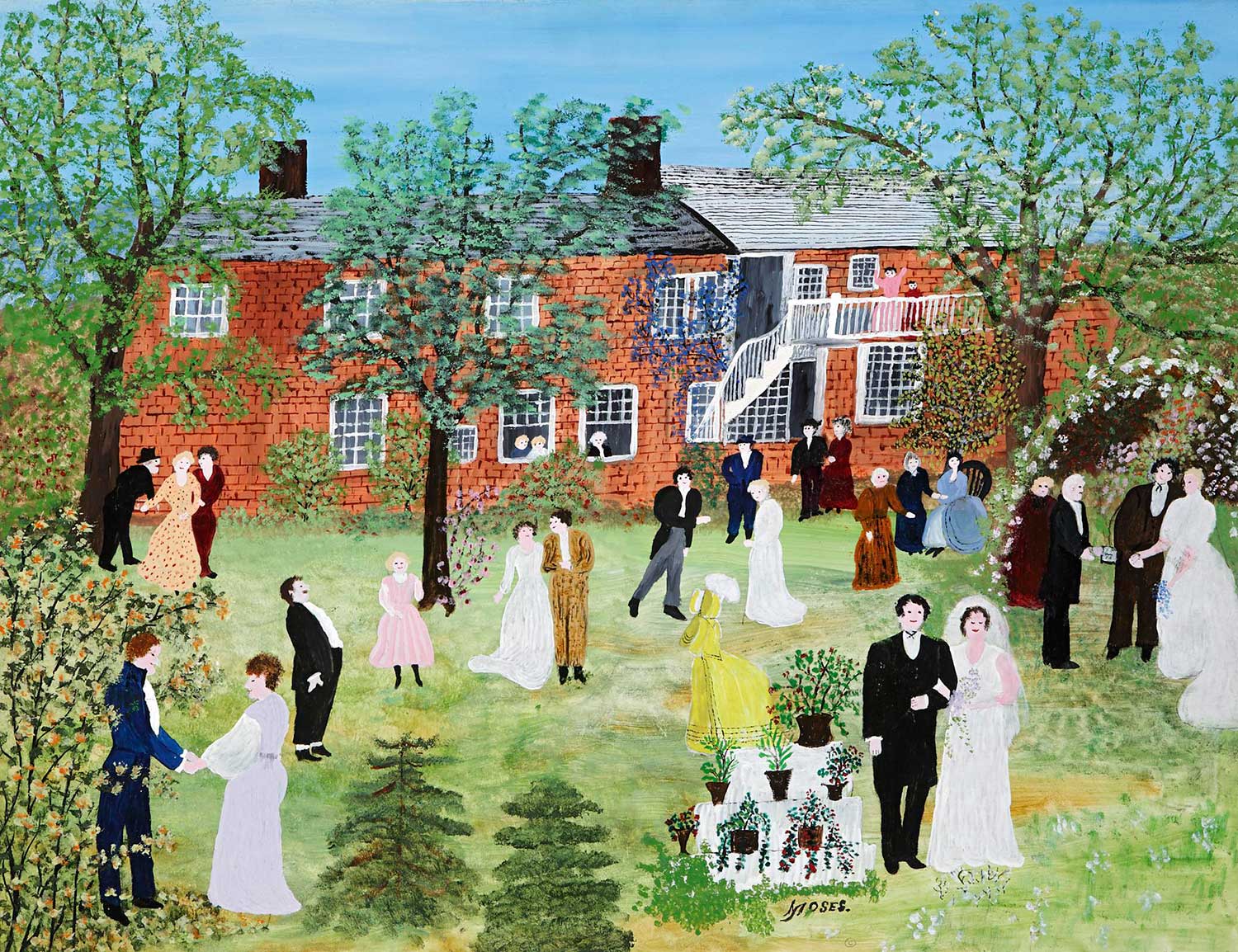
Grandma Moses
In our frenetic, hyperconnected world, it can be easy to become deflated by the endless images of absurdly talented people seemingly effortlessly churning out masterpieces. This can lead to creative paralysis, falling into the trap of perfectionism, or otherwise undermining one's desire to make art. The perfect antidote to this is to step away from your devices, throw out the rulebook, and head for your own magic bubble.
You aren’t going to suddenly unlearn everything you’ve ever been taught or forget the art you’ve already seen and made, but you can consciously and deliberately shift the angle through which you’re viewing things. There are many ways to do this, but let's emphasize some of the go-to techniques that characterize Naïve Art. Namely, simplicity and frankness (or perhaps a conscious rejection of sophistication), imaginative and detailed imagery, bright, saturated colors, and disregard for the rules of perspective.
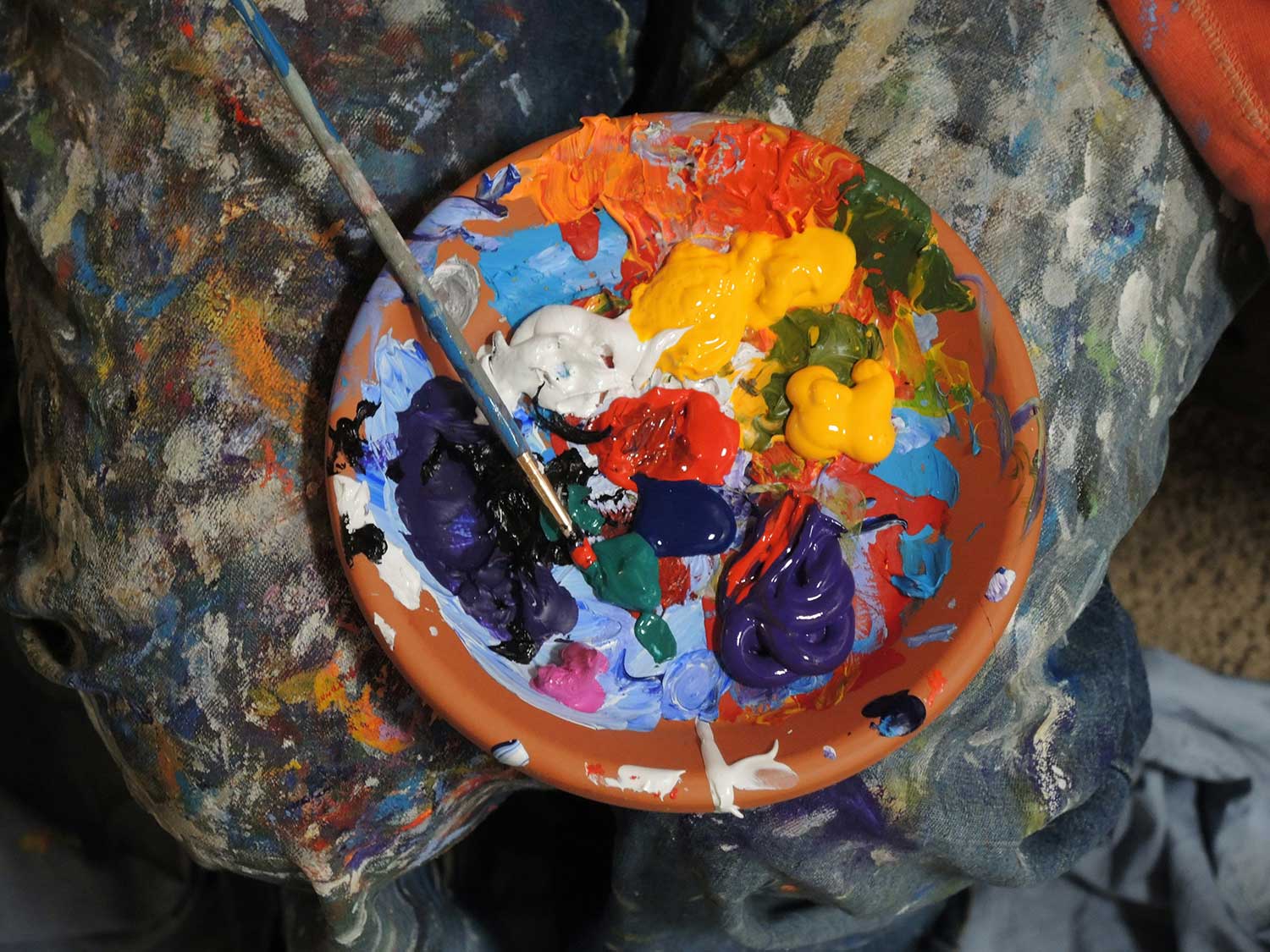
The idea here is to allow what’s in front of you or in your mind’s eye to reveal itself just as you see it. For example, you might be sitting in a garden when a bed of flowers jumps out at you. You see all the colors: orange, periwinkle, deep purple, and yellow, all threaded with variegated verdant hues. Rather than trying to recreate the scene realistically, you simply take each shape and color and let it arrange itself according to your mood. Whimsy is welcome here.
Continuing your exploration of the above garden scene, you might choose to include animals, people, furniture, objects, or anything that strikes your fancy regardless of how absurd, mythological, or out of place in the “real world” these things might be. In addition, you could take each leaf, petal, or other detail of what you are creating and turn it into a repeating motif. In this process, all that is required is to make something that appeals to you visually without concern about whether or not it’s true to life.
As your garden piece progresses, you will want to experiment with using color in a way that pops. For inspiration, you could think about how bright and attractive things can be, so alluring you almost taste them or would like to. Be bold and adventurous, enjoying the lollipop lure of unabashedly brilliant saturated colors.
Foreground, background, scaled color, diminishing detail in the distance- forget about it. Place things wherever you choose and let those bold colors you played with in the previous step retain their luminosity throughout the piece.
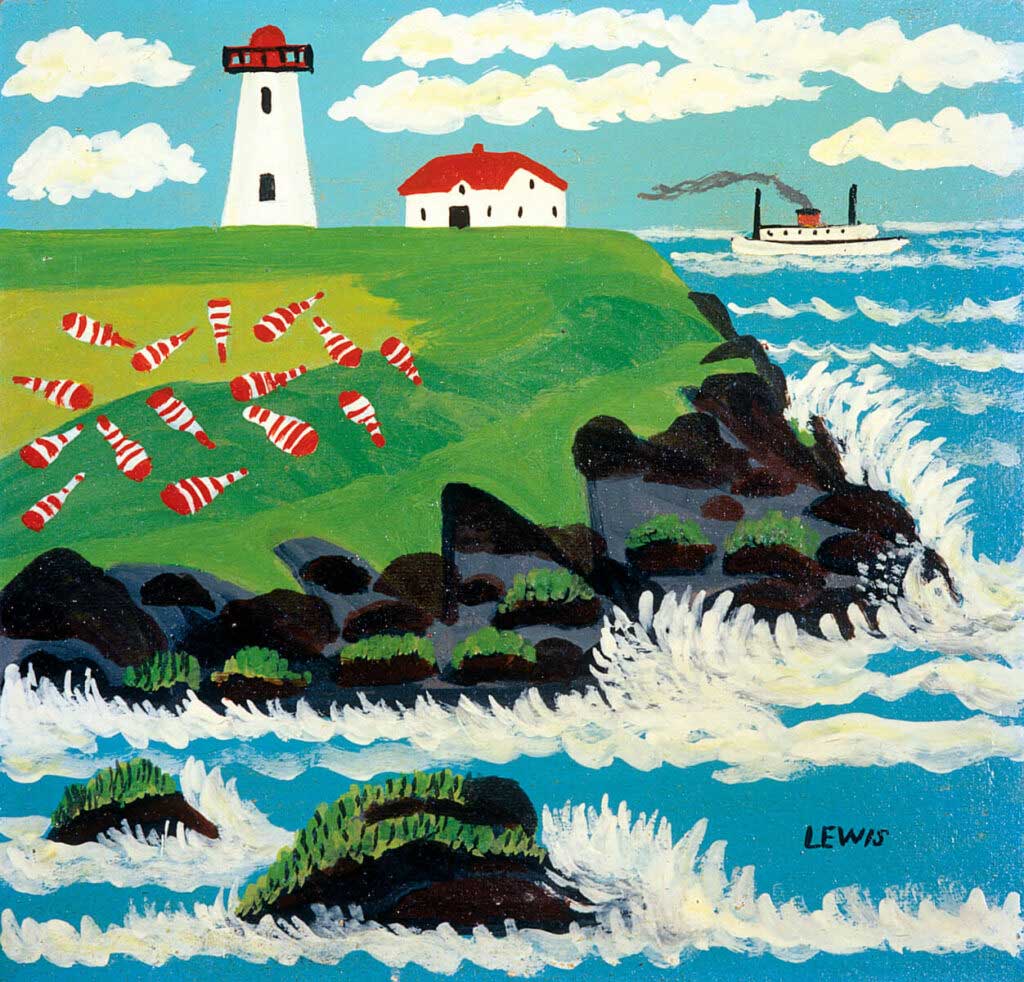
The Lighthouse
By Maud Lewis
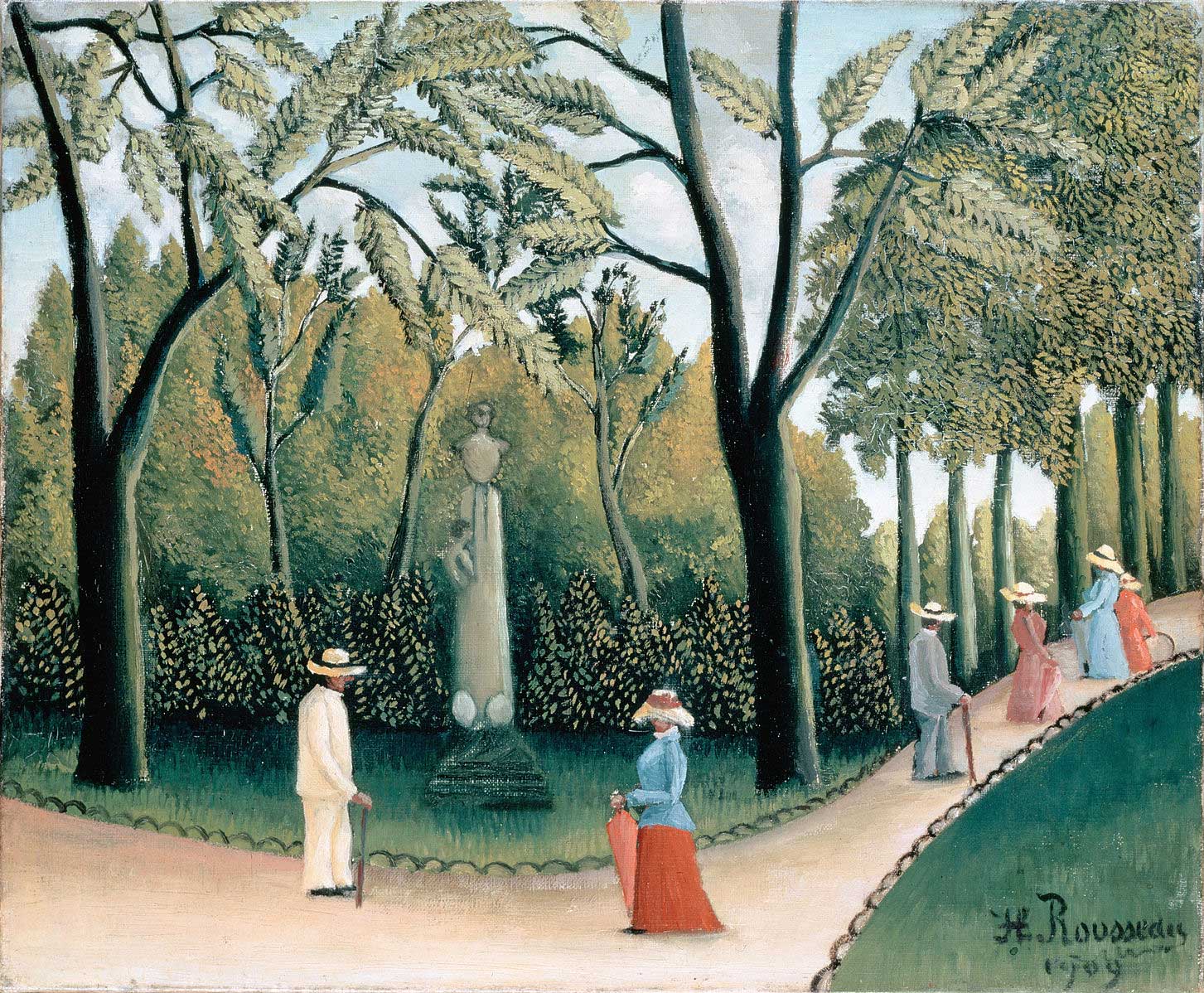
The Luxembourg Gardens. Monument to Chopin
By Henri Rousseau
To paint like a Naïve Artist means to take play seriously. It’s not a suggestion to avoid working tirelessly and diligently but rather an invitation to allow the subject matter and how you present it to be entirely of your choosing. The emphasis here is on creating a visually compelling and emotionally evocative piece, not on conforming to critical standards of art.
So, in the spirit of Henri Rousseau, let’s apply ourselves to making art our way, doing so with gleeful abandon and recognizing the inherent value in what we are doing. Rousseau didn’t consider himself inferior to trained artists; in fact, he dedicated himself to learning and creating on his own terms and was ultimately encouraged by those in esteemed circles to retain his naïve style. He also inspired avant-garde movements, from Cubism to Surrealism, paving the way for the art world to become a more interesting place. By tapping into this innovative, naïve essence, we can liberate ourselves as artists and, in so doing, ignite our creative spark, infusing our work with joy.

The dictionary definition of "playful" according to the Merriam-Webster Dictionary is:
Playful (adjective):
1. Full of play: Frolicsome, Sportive
2. Humorous, Jocular
So, how does this word relate to us and our theme(s) this month?
ART AND LIGHT
• Joyful Experimentation: Naïve artists often approach their work with a sense of fun and experimentation, free from the constraints of formal training and conventional techniques. This playful approach encourages us to explore and create without fear of making mistakes.
• Unconventional Techniques: The playful nature of Naïve art allows us to use unconventional methods and materials, fostering creativity and originality. This encourages us to step out of our comfort zones and try new things.
• Childlike Wonder: Naïve art often embodies a childlike perspective, full of wonder and curiosity. When we are inspired by this movement we can tap into our inner child, rediscovering the joy and spontaneity that can sometimes be lost with formal education and experience.
• Emotional Expression: Playfulness in art can lead to more genuine and heartfelt expressions. By embracing the playful spirit of Naïve art, we can create works that resonate emotionally with our audience, conveying joy, humor, and a sense of freedom.
• Simplicity and Directness: The simplicity and directness of Naïve art, often achieved through playful expression, can help us focus on the essence of our subject matter, stripping away unnecessary complexity to reveal the core emotions and ideas.
In essence, the playful nature of Naïve art serves as a reminder for us to approach our work with joy, curiosity, and a sense of adventure, fostering creativity and innovation. I think we ALL could use this reminder right?!
Let’s tap into our creative intuition and do some self-reflective work inspired by our theme. Below you will see our month’s Oracle/Tarot card spread. But fear not, if you are not one drawn to using oracle or tarot cards, no worries, just use the accompanying reflective questions as writing prompts for your journals!
USING THE SPREAD
- Shuffle your deck while focusing on your intentions and the questions posed for each card.
- Draw three cards,, laying them out in the order of Observation, Color, and Illumination.
- Reflect on each card,, considering both the symbolism of the card itself and its position in the spread. Take time to journal or meditate on the reflections and insights you gather.
This spread is designed to help you delve deeper into the nuances of how you see and interact with the world around you, using the metaphorical lenses of observation, color, and light. It's an excellent tool for us creatives looking to enhance their perceptual and emotional awareness through self-reflection.

This meditation is a journey in physical and emotional healing, in listening to the energies of our body and how it speaks to us. We meditate together in the woods and allow ourselves to be comforted by a healing divine light of gold and white. A kaleidoscope of butterflies joins us in the sunlit woodland and continues to harmonise our energies.
I hope you enjoy.
lots of love,
Rachel
Each month we will have a positive affirmation. I recommend you print out this affirmation and put it in your sketchbook or somewhere in your studio. Recite the affirmation out loud each time you show up to create. Saying words aloud is powerful and can begin to re-write some of our own limiting beliefs or calm our fears. Try it now…
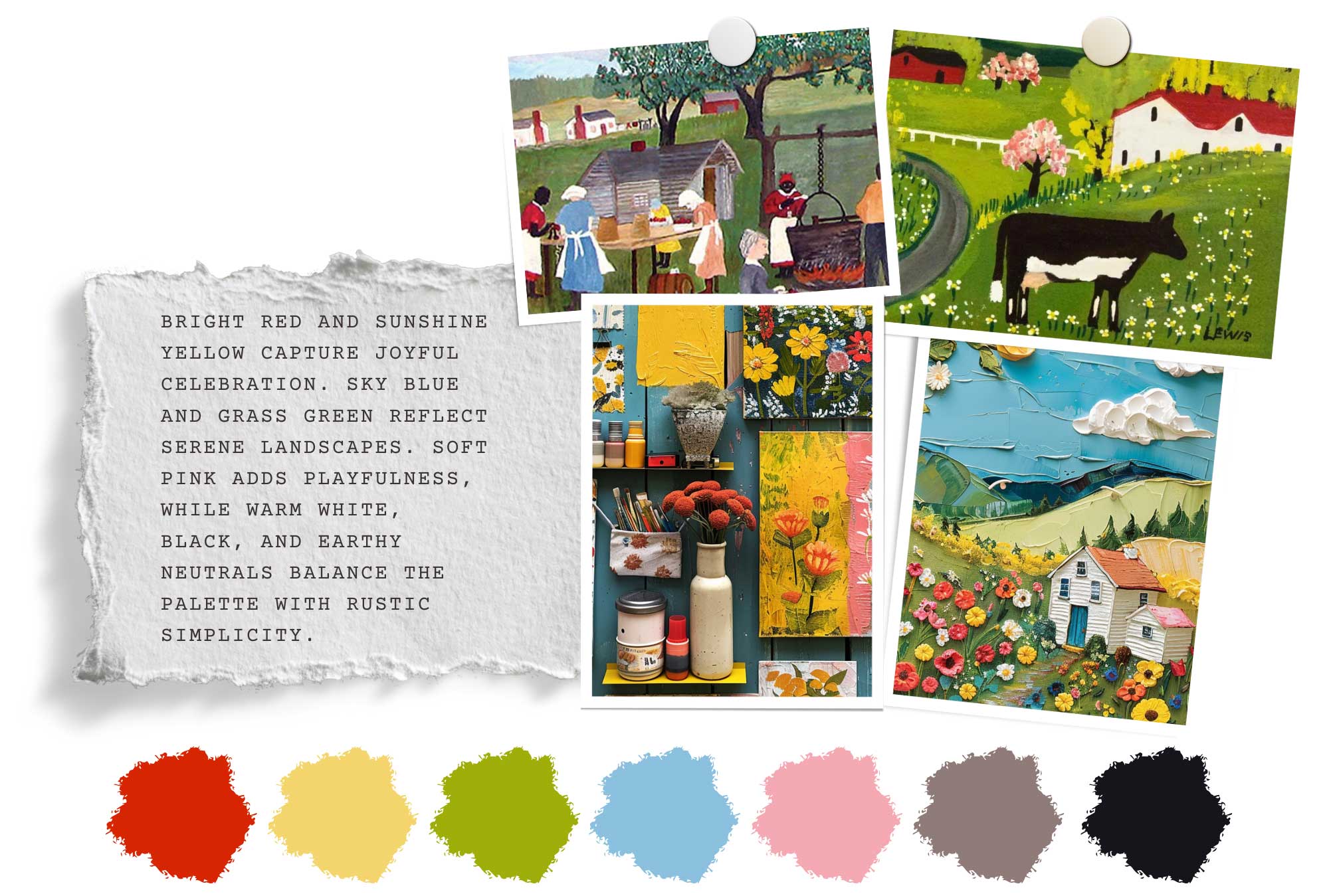
In this edition, we immerse ourselves in the vibrant palette of our master artists, Grandma Moses and Maud Lewis, whose joyful depictions of rural and coastal life resonate deeply within the colors we’ve selected to highlight our theme of joy, wonder, and the inner child.
Bright red and sunshine yellow reflect the cheerful barns, clothing, and festive elements that dominate Grandma Moses' lively rural scenes, capturing the essence of joyful celebration and warmth. Sky blue and grass green mirror the serene skies and lush landscapes prevalent in both artists' works, evoking a sense of tranquility and natural beauty. Soft pink adds a playful touch, reminiscent of the flowers. These vibrant and engaging colors are balanced by warm white, black and earthy neutrals, which recall the purity of snow-covered fields and the rustic charm of rural structures, grounding the palette with simplicity and authenticity.
Together, these colors do more than just evoke the aesthetic of Grandma Moses and Maud Lewis's paintings; they invite us to explore the pure, unfiltered creativity and joy that these artists captured so masterfully.
In the world of Naïve Art, few figures stand as prominently as Grandma Moses and Maud Lewis. Their lives and works offer profound insights into the beauty of rural life and the resilience of the human spirit. Despite starting their artistic journeys later in life and facing significant personal challenges, both artists created vibrant, joyful paintings that continue to inspire and captivate audiences worldwide. This article provides a historical overview of their lives and explores how their art embodies themes of playfulness, joy, and resilience, offering a timeless reminder of the power of creativity to transform and uplift.
A BRIEF OVERVIEW OF THEIR LIVES
Grandma Moses (Anna Mary Robertson Moses) was born on September 7, 1860, in Greenwich, New York. Her upbringing on a family farm instilled in her a strong work ethic and a deep appreciation for rural life. She initially expressed her creativity through embroidery and quilting, but as arthritis began to affect her hands in her seventies, she turned to painting. This late-in-life career shift proved fortuitous, as her depictions of rural American life quickly garnered attention. By the 1940s, Grandma Moses's works were being exhibited in galleries and museums, bringing her national and international acclaim. She continued to paint until her death in 1961, leaving behind a legacy of over 1,500 paintings that celebrate the simple joys of country living.
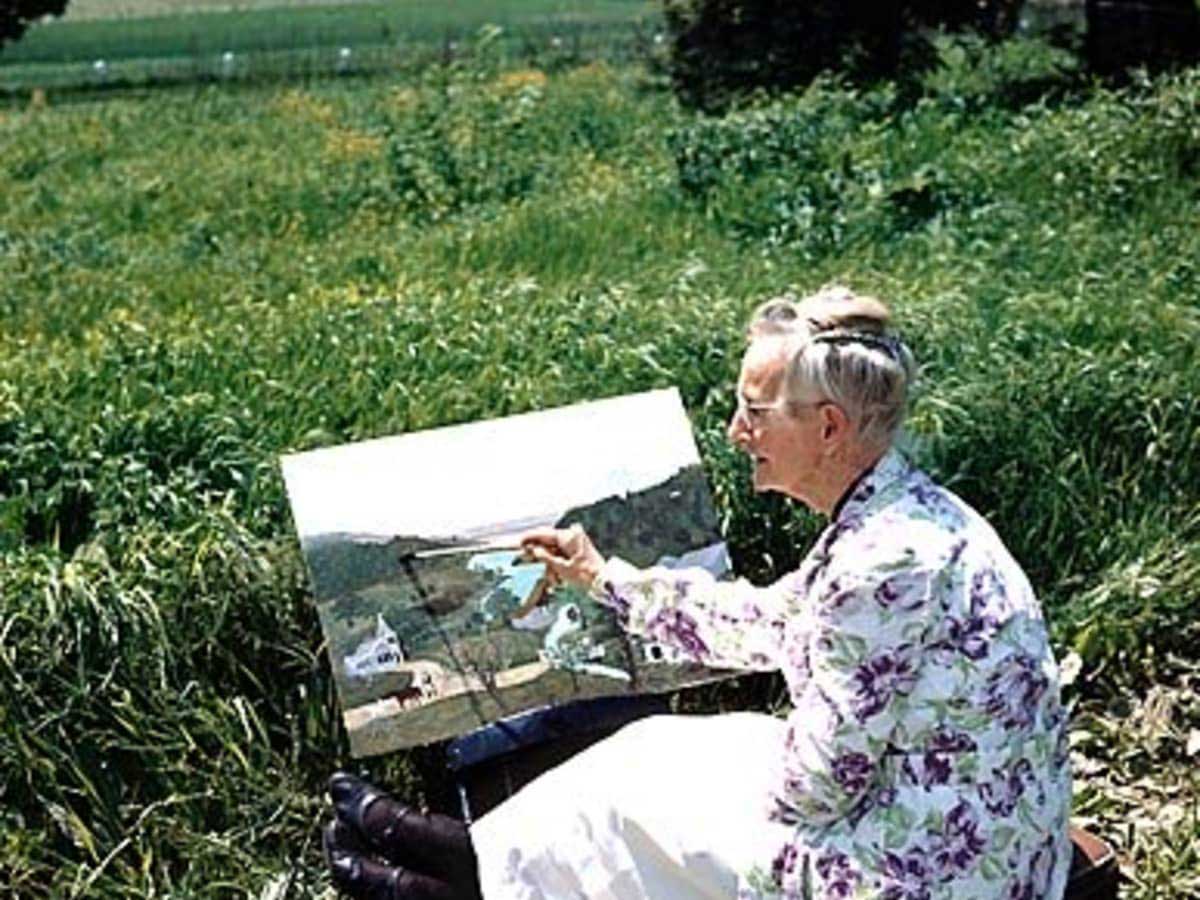
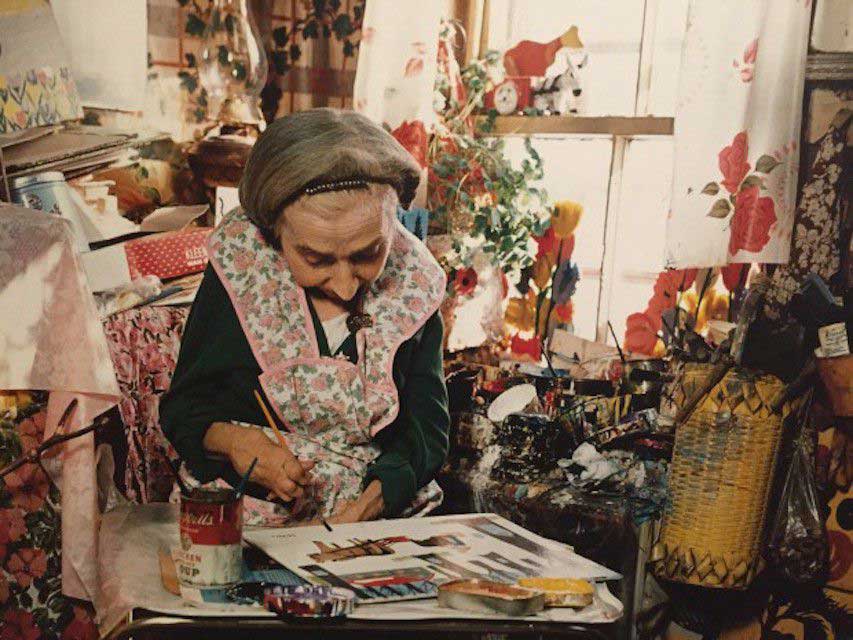
Maud Lewis was born on March 7, 1903, in South Ohio, Nova Scotia. From an early age, she suffered from juvenile rheumatoid arthritis, which limited her mobility and physical capabilities. Despite these challenges, Maud found solace and joy in painting. She started by creating holiday cards, which she sold locally, before moving on to larger pieces. Her marriage to Everett Lewis brought her to a tiny house in Marshalltown, Nova Scotia, where she began covering every surface with her bright, cheerful art. Her work, often featuring vibrant depictions of local landscapes, animals, and flowers, gradually gained recognition. By the 1960s, Maud Lewis had become a beloved figure in Canadian folk art, continuing to paint until her death in 1970.
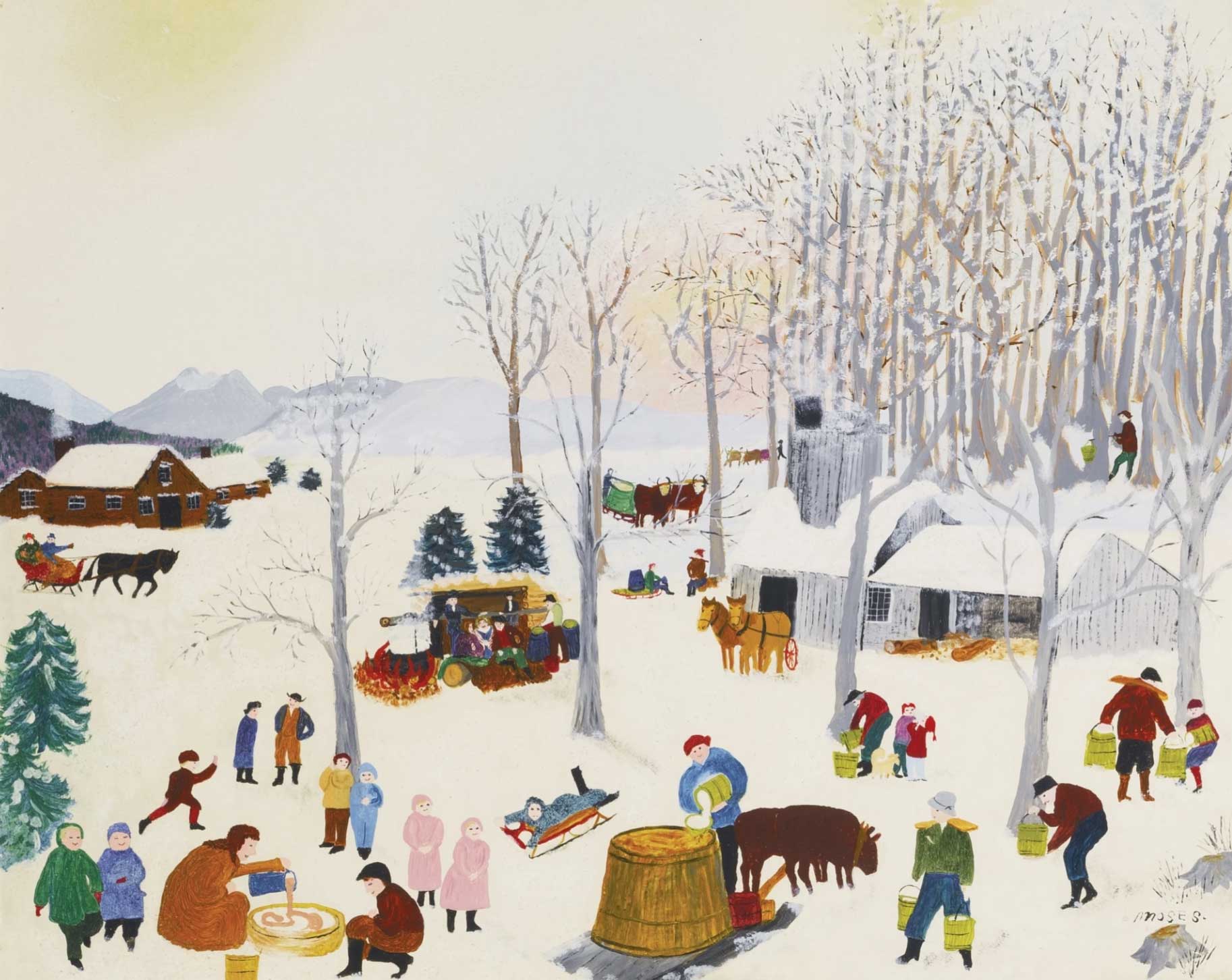
Sugaring Off
Grandma Moses 1942
CELEBRATING RUAL LIFE
Both Grandma Moses and Maud Lewis are celebrated for their depictions of rural life, but their approaches and styles reflect their unique perspectives and experiences.
Grandma Moses’s paintings are often detailed scenes of farm life, community gatherings, and seasonal activities. Her work is characterized by a nostalgic charm that harkens back to a simpler, more idyllic time. She used bright colors and meticulous details to create lively, bustling scenes that convey a sense of community and tradition. Her works, such as “Sugaring Off” and “The Old Checkered House,” capture the rhythm and beauty of rural existence, inviting viewers into a world of pastoral tranquility.
Maud Lewis’s art, on the other hand, is noted for its vibrant color palette and whimsical style. Her paintings often depict the landscapes and daily life of rural Nova Scotia with a sense of innocence and joy. Despite her physical limitations and modest means, Lewis’s work exudes an infectious positivity. Pieces like “Oxen in Winter” and “Three Black Cats” are filled with playful details and bright, bold colors that celebrate the beauty and simplicity of the world around her. Her art reflects an unfiltered delight in everyday scenes and the natural environment.
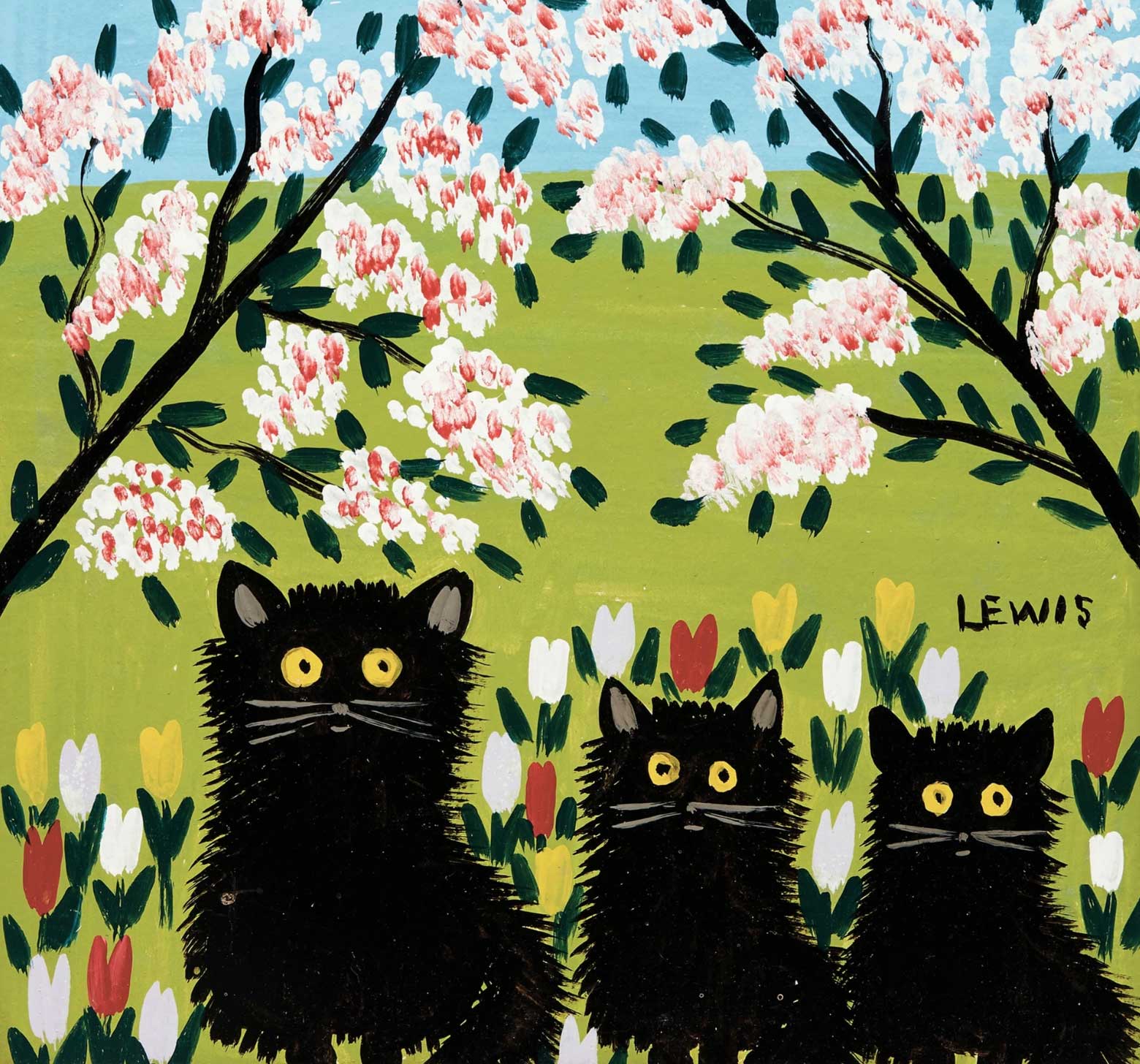
Three Cats
Maud Lewis, 1955
The works of both artists are imbued with a profound sense of joy and resilience.
Grandma Moses’s paintings often highlight the collective joy of community activities and seasonal celebrations. Her portrayal of these events underscores the importance of community bonds and shared traditions in sustaining rural life. Despite beginning her artistic career late in life, Moses’s passion and dedication to her craft exemplify a remarkable resilience and an enduring creative spirit.
Maud Lewis’s work is similarly marked by joy and an indomitable spirit. Living in challenging circumstances, she found joy in the act of creation and shared that joy with others through her vibrant paintings. Her art is a testament to her resilience, demonstrating how creativity can flourish despite physical and economic hardships. The cheerful, colorful scenes she created stand in stark contrast to her difficult life, offering a message of hope and positivity.
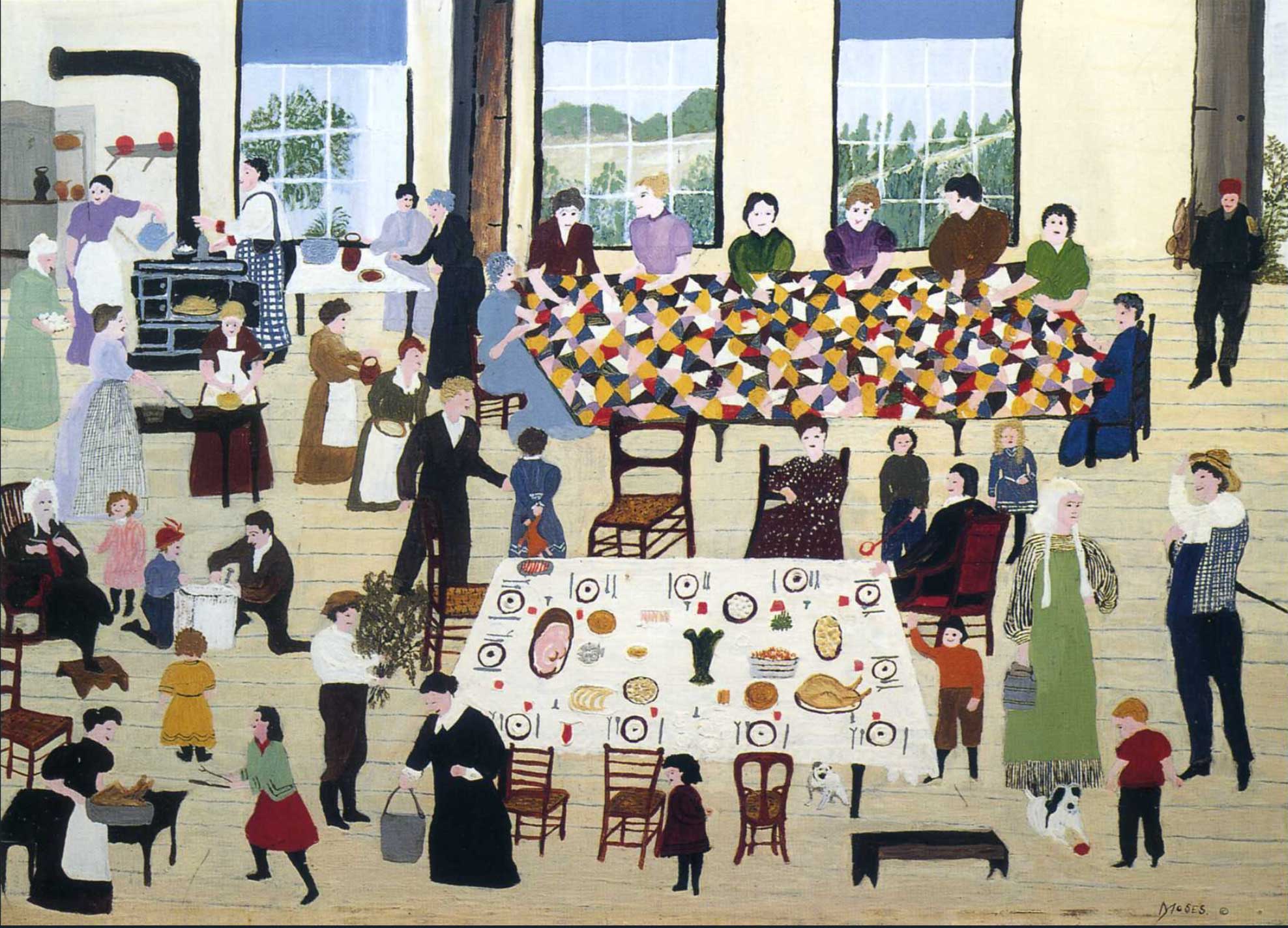
The Quilting Bee
By Grandma Moses, 1940
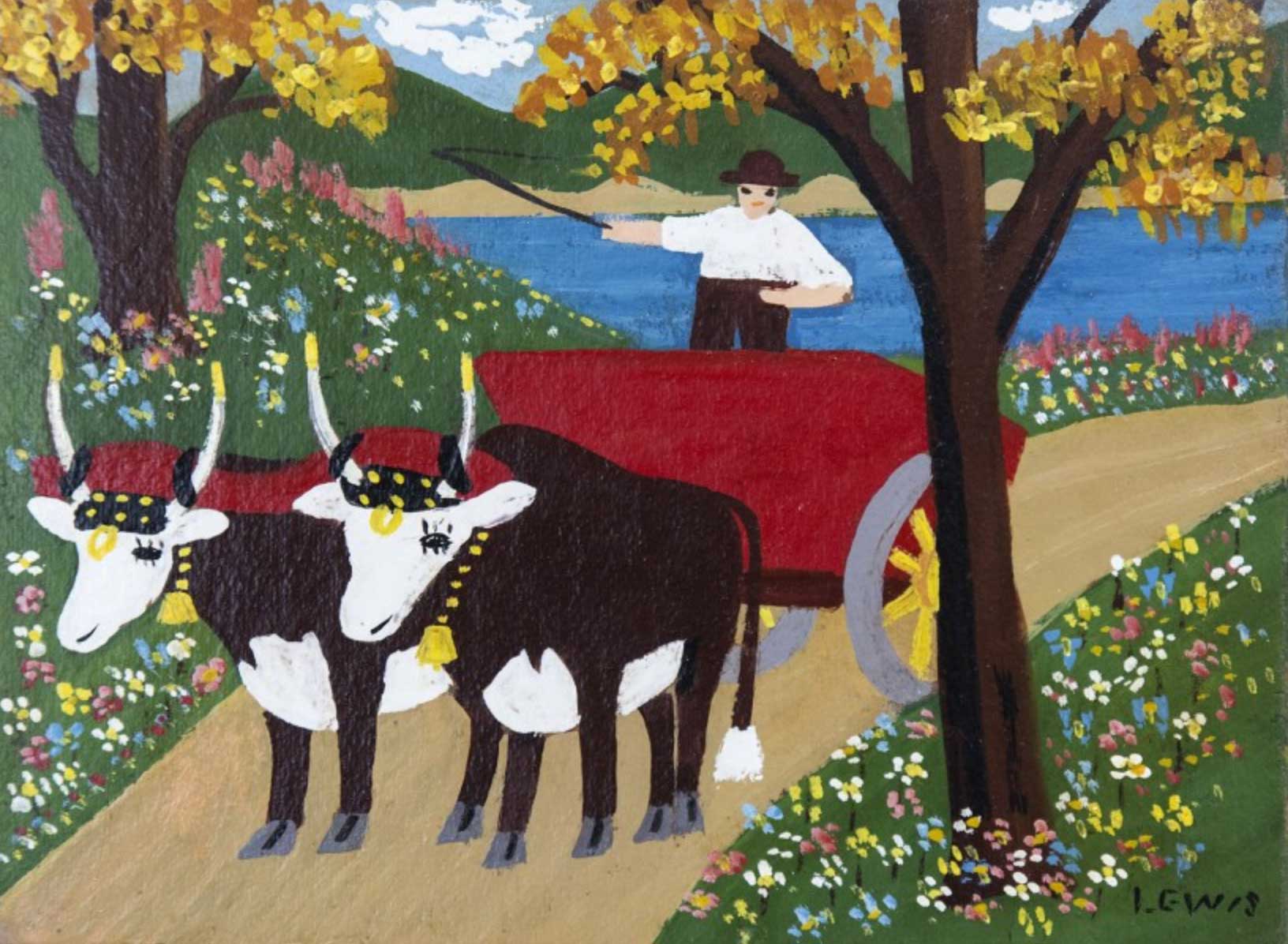
Oxen in Springtime
By Maud Lewis, 1962
The legacies of Grandma Moses and Maud Lewis extend far beyond their lifetimes. Both artists have made significant contributions to the world of folk art, bringing the beauty of rural life to a wider audience and inspiring countless others with their stories and their work.
Grandma Moses’s success helped to elevate folk art within the broader art community, proving that artistic talent and creativity are not bound by formal training or age. Her works continue to be celebrated for their historical and cultural significance, offering a window into the rural American experience of the late 19th and early 20th centuries.
Maud Lewis’ art has become iconic in Canadian culture, symbolizing the joy and resilience of the human spirit. Her life and work have been the subject of numerous exhibitions, books, and a feature film, ensuring that her legacy continues to inspire new generations of artists and admirers.
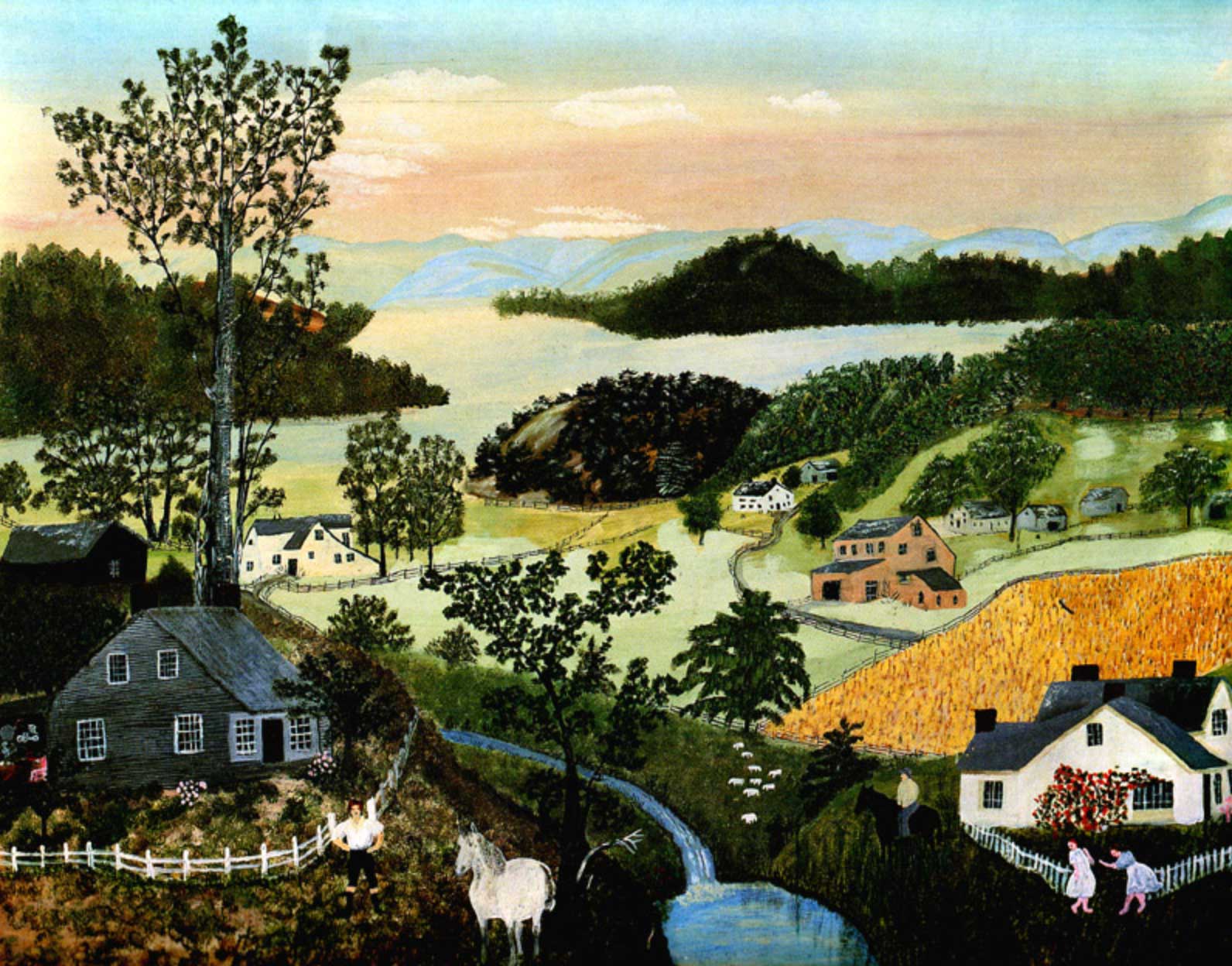
A Beautiful World
By Grandma Moses, 1948
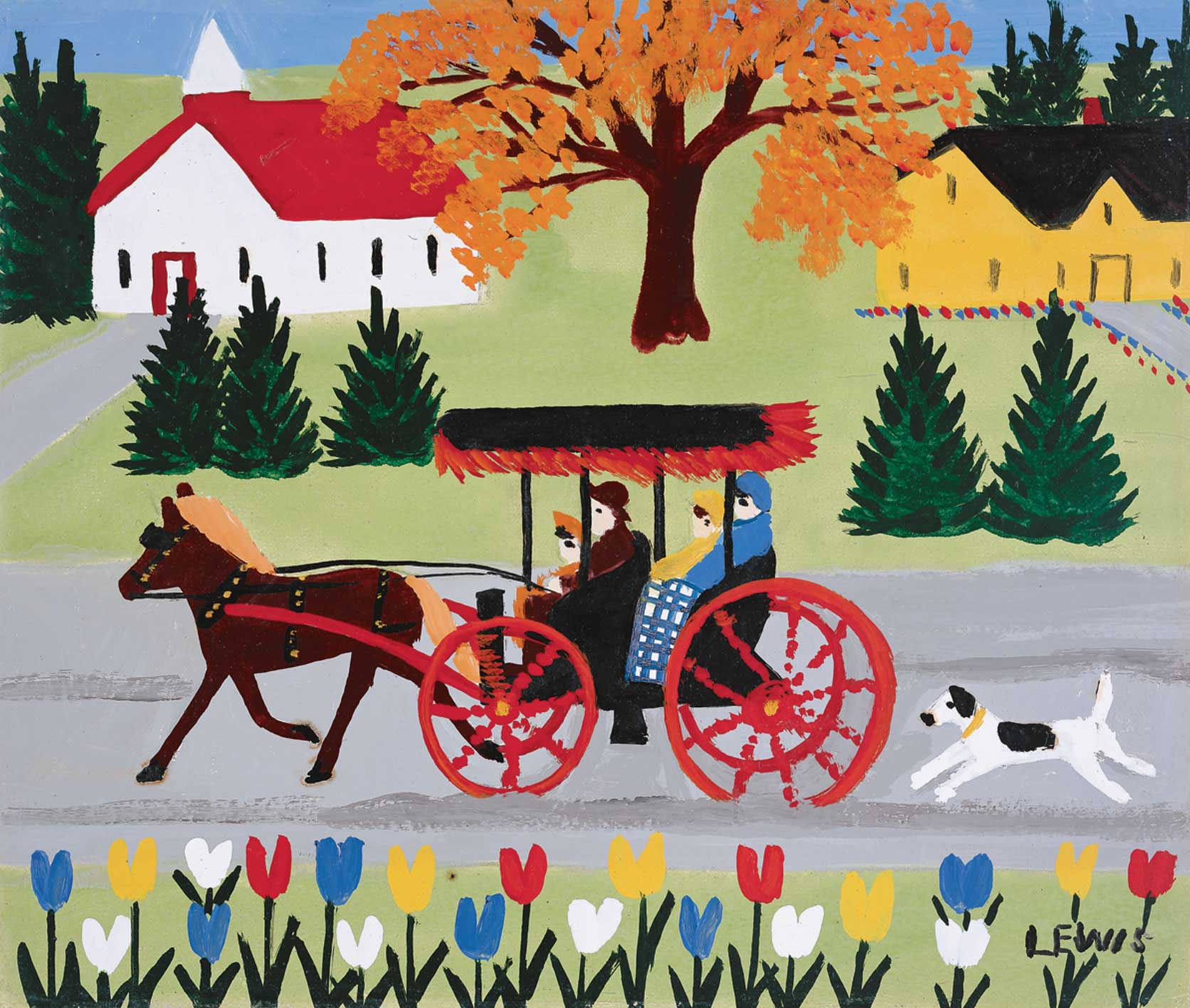
Carriage and Dog
By Maud Lewis, 1960
The art of Grandma Moses and Maud Lewis offers a unique and inspiring perspective on rural life, imbued with joy, playfulness, and resilience. Their works remind us of the beauty in simplicity and the power of creativity to overcome adversity. Through their paintings, both artists invite us to see the world through their eyes—filled with wonder, delight, and an enduring appreciation for the everyday moments that make life special. Their legacies continue to inspire, reminding us that it is never too late to pursue our passions and that joy can be found in even the most modest of circumstances.
Art was and always has been my thing. It's been my steadfast friend. I was constantly drawing as a child (and now, too). I made cards for my family and they have all always encouraged me. My mom always brought home new art supplies for my twin sister and I to try out. I loved coloring books. - Gloria Lynn Walker
I enjoyed drawing everything but probably plants and flowers were already my favourites. I still have 3 school books dating back to when I was 8 or 9 on subjects like history and nature which have lots of drawings in them, probably copied from somewhere but drawings nevertheless. We also used to make moss gardens on trays. I had a dolls house inhabited by bears and we would take them for picnics on my brother's toy train. - Carol Abel
I loved doodling, mostly botanicals. All my notebooks in school were covered with doodles. It was easier for me to focus when I was doodling. I also loved knitting and made sweaters and scarves for my friends. - Inbar Singal
What I remember is the coloring contests. I would work hard to make the photocopied picture unique, like making bricks on a fireplace look like bricks and adding my own drawn photo frames sitting on the shelves. I always got second place, but still entered every year. Art didn't become a regular part of my life until much later. I find it challenging to play to this day and was a serious child..an old soul was always how I was described. - Brook McKenzie
I had a big half pan child’s grade watercolour metal box .i painted non stop with that set .My crayons also ,I even coloured rocks with my crayons .I used pastels and also poster paints .i was always colouring or painting. - Elizabeth Mitchell
I loved creating mosaics on large pieces of dry wall. My favorite was an undersea collage of fish, sea shells and seaweed. I used dry goods and Elmer’s glue. Today I am an assemblage artist. - Susan Mason
I used to turn the letters of the alphabet, written in script, into little people. - Joan Traas
Drawing used to be fun as a kid! I loved playing around and just seeing what came up in a scene! - Nikki Condon Winkle
Grandma Moses spent the majority of her life on the farm, balancing the demands of household chores and raising her family. Her creative inclinations first found expression in embroidery and quilting, which she enjoyed in her spare time. Little did she know that her artistic journey would take a dramatic turn later in life.
In her 70s, arthritis made it increasingly difficult for Moses to continue with her needlework. Instead of giving up her creative pursuits, she adapted by picking up a paintbrush. What began as a simple pastime to keep her busy soon blossomed into a new and profound calling. Her paintings, which depicted nostalgic and idyllic scenes of rural American life, quickly gained attention for their charm and authenticity.
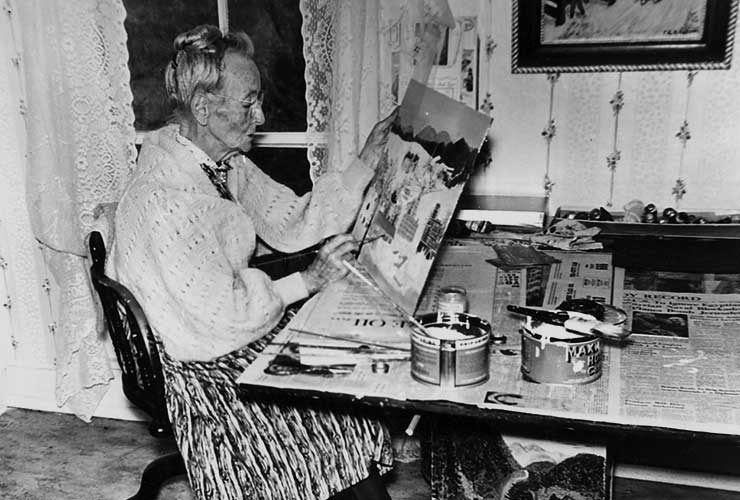
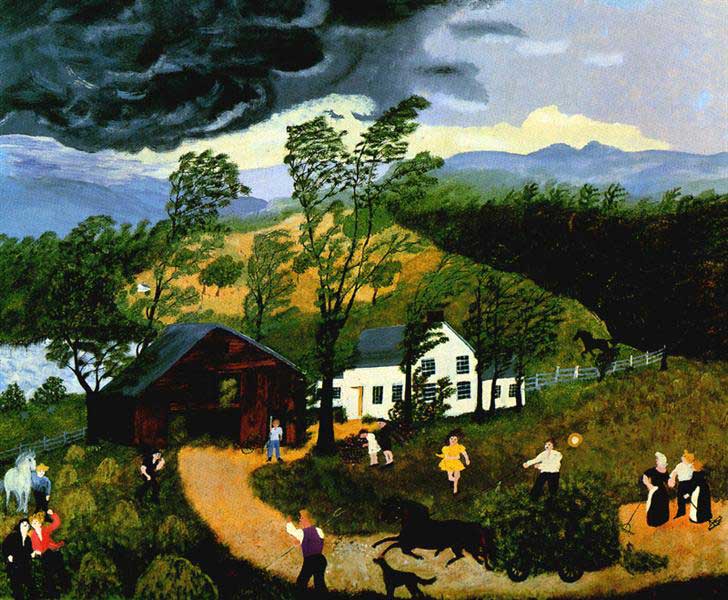
Grandma Moses's rise to fame was nothing short of remarkable. At the age of 78, her work was discovered by a New York art collector who saw her paintings in a local drugstore window. He was captivated by the simplicity, vivid colors, and heartfelt depictions of rural life. This chance encounter led to her first solo exhibition in 1940, which was met with critical acclaim.
Her fame grew rapidly, and soon her paintings were being exhibited in prestigious galleries and museums across the United States and Europe. Moses's art resonated with people from all walks of life, offering a nostalgic glimpse into a world of simplicity and joy that many yearned for during the rapidly changing times of the mid-20th century.
Grandma Moses continued to paint until her death at the age of 101. Over her three-decade-long painting career, she created more than 1,500 works of art. Her paintings are celebrated for their vibrant colors, meticulous detail, and the joyful spirit they convey. She left behind a legacy that continues to inspire artists and non-artists alike.
Her story is a powerful reminder that it's never too late to start following your passion. Moses's success defies the conventional notion that creative pursuits are reserved for the young. She demonstrated that with determination and a willingness to adapt, one can achieve great things at any stage of life.
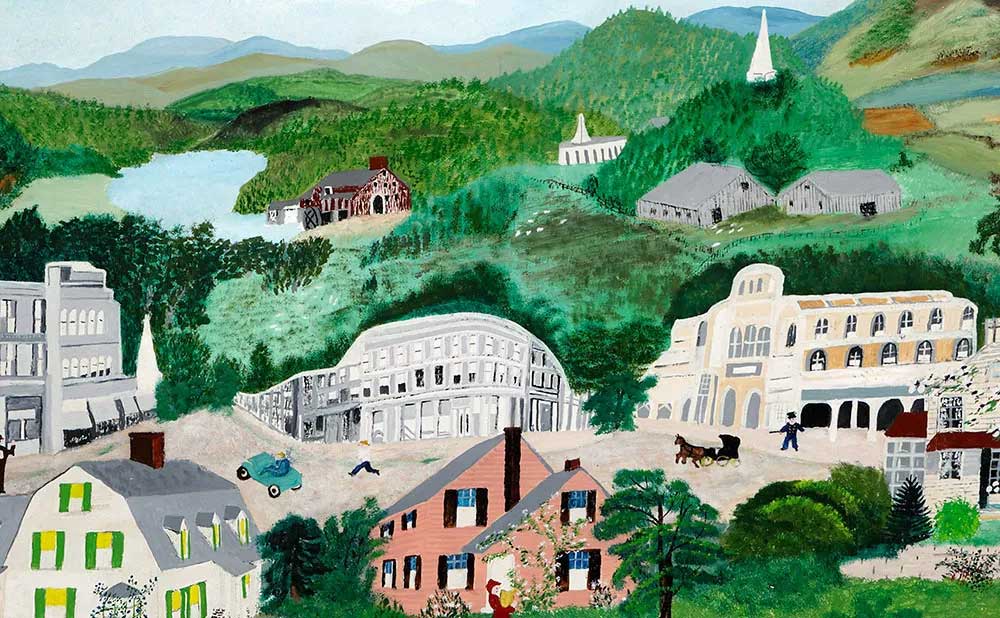
Grandma Moses's life is an inspiring example of how it's never too late to follow your passion for creativity. Her story encourages us to embrace our dreams, adapt to challenges, and find joy in the journey. In a world that often emphasizes youth and quick success, Grandma Moses reminds us that true fulfillment and creativity can flourish at any age. Her legacy continues to inspire us to pursue our passions with enthusiasm and to believe in the limitless possibilities that lie ahead, no matter our stage in life.
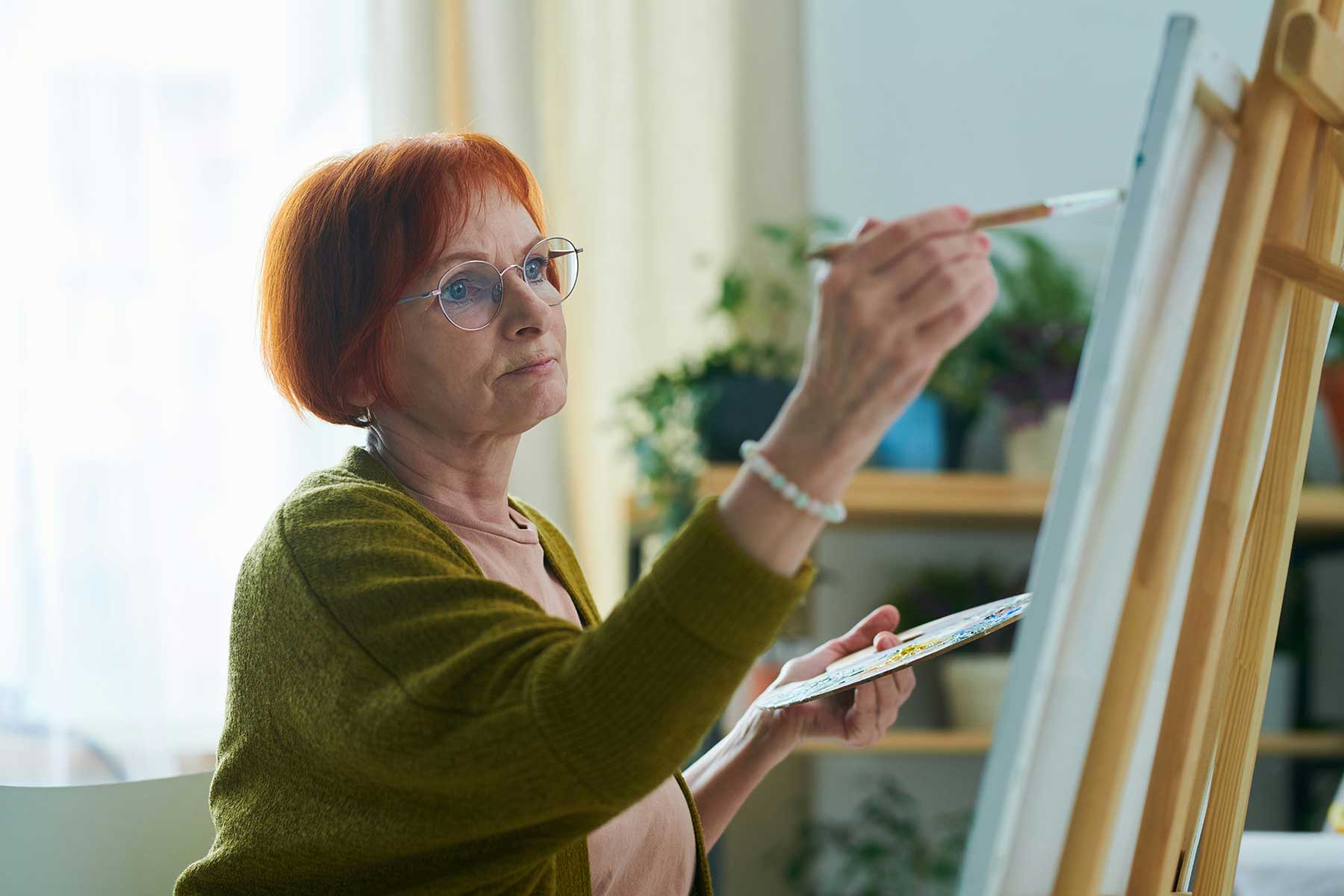
Here are three sketchbook exploration ideas that tie beautifully into the themes of observation, light, and color, inspired by Joaquín Sorolla’s techniques. These exercises are designed to help us deepen our understanding of these elements and refine our skills.
- Spend a day observing and sketching everyday scenes that bring you joy. This could be children playing in a park, people gathering at a local café, or even your own family during a meal.
- Use bright, cheerful colors to highlight the elements that make these scenes joyful.
- Focus on capturing the essence of the moment rather than the details, much like Grandma Moses did with her rural scenes.
- Add notes or short descriptions in your sketchbook about what made each moment special to you.
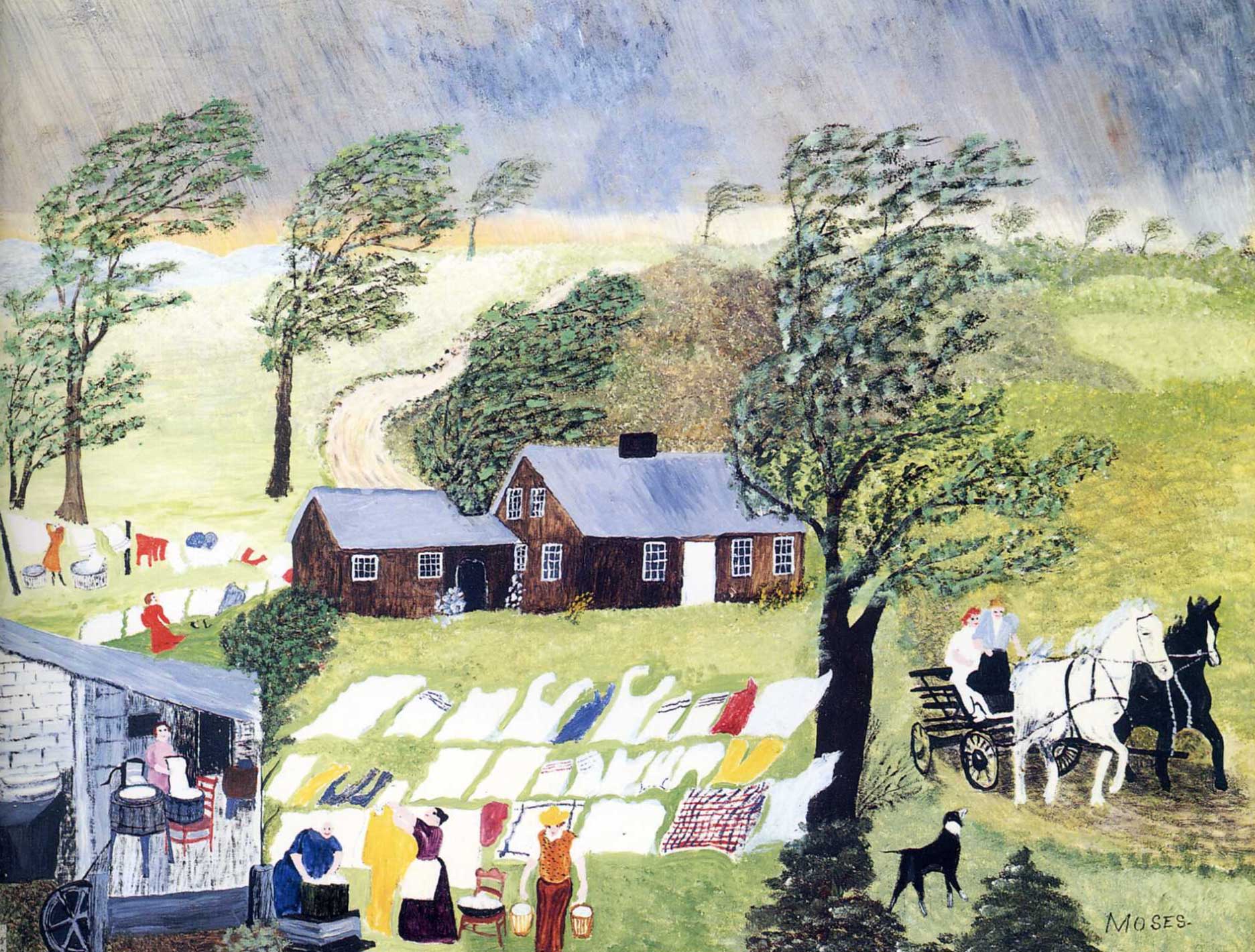
Taking in the Laundry
By Grandma Moses, 1951
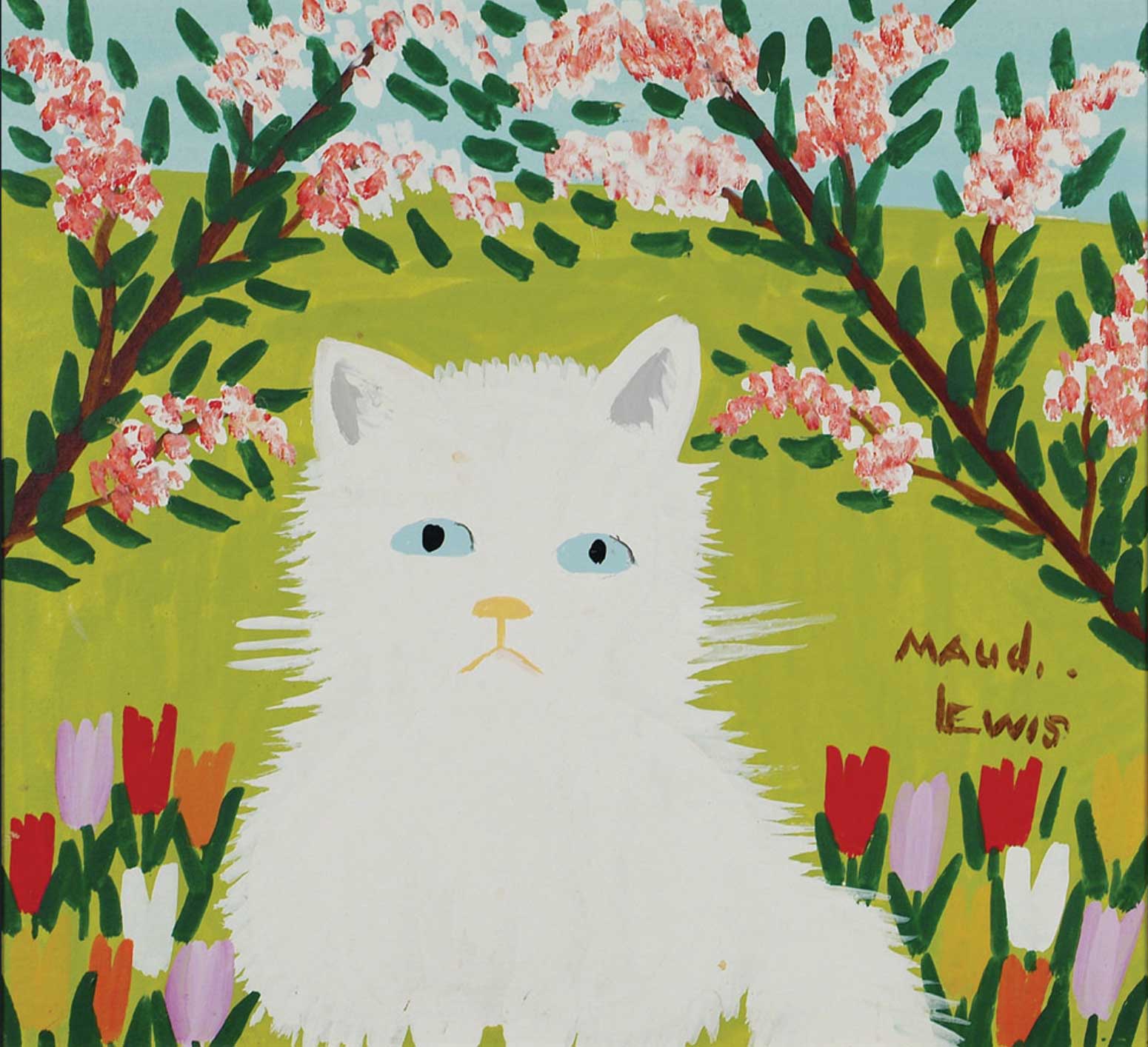
White Cat (Fluffy)
By Maud Lewis, 1960
- Draw inspiration from Maud Lewis’s vibrant depictions of animals and nature. Choose a few animals that you find endearing or playful OR you can use a beloved pet as inspiration.
- Create sketches of these animals in playful poses or engaging in fun activities. Feel free to use imaginative settings, such as a cat playing with a ball of yarn or a bird dancing in the rain.
- Incorporate bold, primary colors to give your sketches a whimsical and lively feel.
- Experiment with different media (e.g., colored pencils, markers, watercolors) to bring out the playful nature of your subjects.
- Recall a favorite childhood memory or an imaginary world you created as a child. Sketch scenes that bring these memories or fantasies to life.
- Use simple, bold lines and bright colors to capture the innocence and wonder of your inner child.
- Don’t be afraid to let go of realism; embrace the fantastical and the whimsical. Think of elements like flying houses, magical gardens, or characters from your favorite childhood stories.
- Include playful patterns and decorative borders around your sketches, much like Maud Lewis’s detailed yet simple compositions.
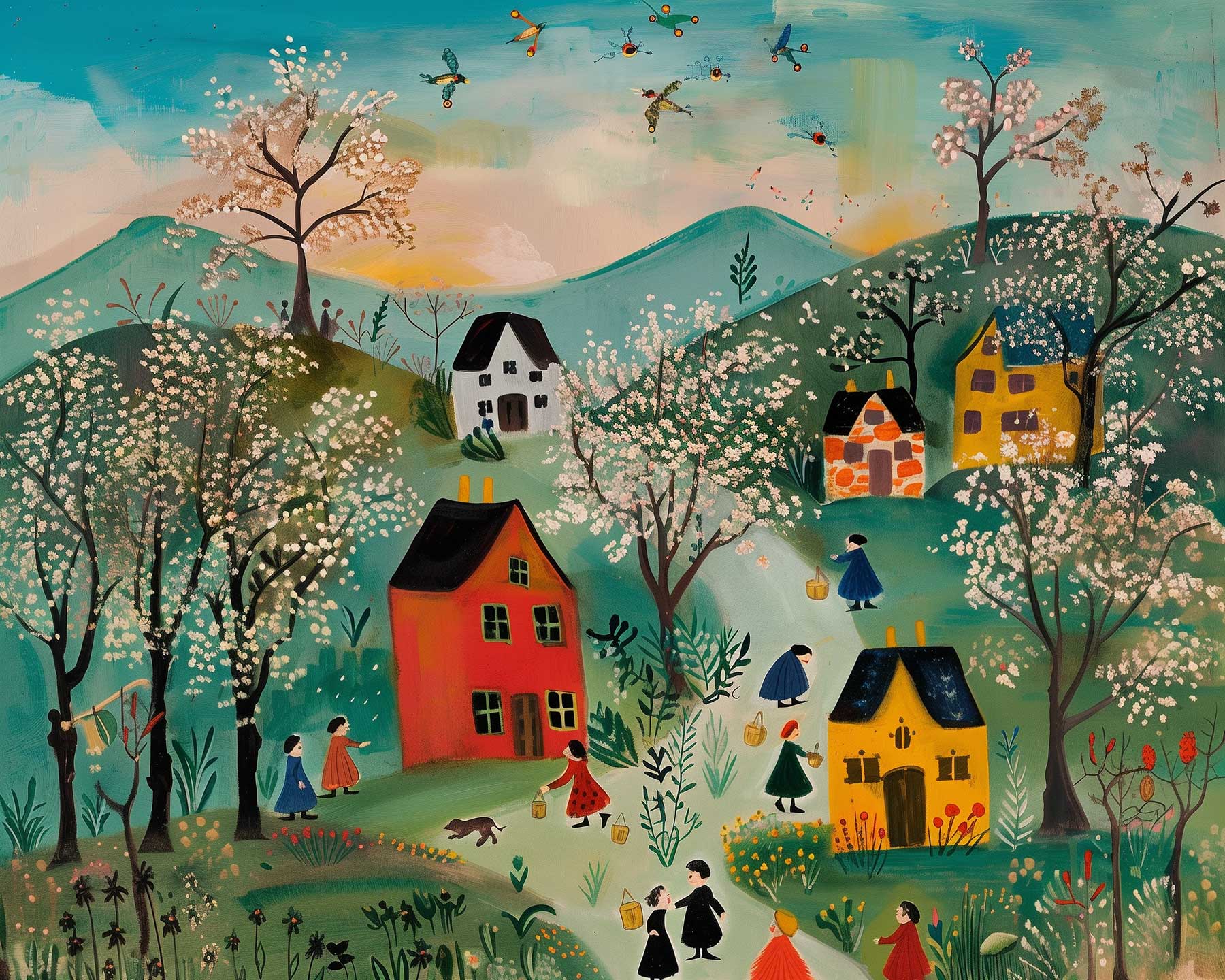
These sketchbook explorations encourage you to embrace the playful, joyful, and imaginative aspects of your creativity, much like Grandma Moses and Maud Lewis did in their art.
This month we're visiting a wonderful lesson by Yvonne Morell. For this lesson, Yvonne invites you to paint an island… what island that will be is up to you.
Some ideas: a tropical island, an island full of animals, a flower island or maybe it is market day and the streets are filled with vegetables and people!
You can also listen to this month’s issue of the Studioworks journal. I find I love listening to books, podcasts and music while I draw, paint or go on a long walk. Enjoy.


One of my favorite things to do is to curate inspiration. From Pinterest boards to books, resources, playlists and more - I love to share anything that might facilitate learning, expansion, and sparks of curiosity! Being an artist, we naturally crave these things so here are some of this month’s picks from me to you.
I had so much fun curating this list. I hope you enjoy!!
Here are just a few of our fantastic classes! I highly recommend checking them out if you haven’t already. Enjoy!